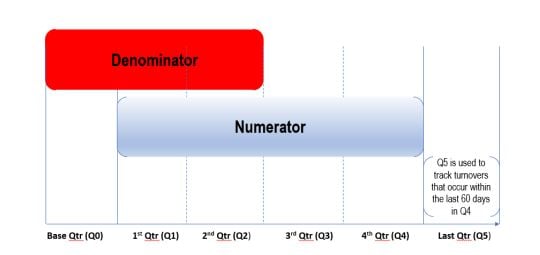January 26, 2022 | Peter Corless
January 26, 2022 | Peter Corless
The Centers for Medicare & Medicaid Services (CMS) recently announced that weekend staffing and staff turnover will be published on the Medicare.gov Care Compare website starting this month (January 2022). These metrics will be used in the Five-Star Quality Rating System starting in July 2022. The way staffing metrics, especially turnover, have historically been calculated can vary greatly by organization. CMS asserts that these new reports will provide additional guidance and standardization on what matters to those selecting skilled nursing facilities.
CMS’s technical document that covers these measurements can be overwhelming, but is a critical document to reference. Below, we break down the calculations so you can get a simpler overview of what your organization needs to know about the new reporting.
CMS defines staff turnover as: “The percentage of nursing staff and number of administrators that stopped working at the nursing home over a 12-month period.” CMS will post turnover measures for total nursing staff, registered nurses and nursing home administrators on the Care Compare website starting this month (January 2022) based on prior Payroll-Based Journal System (PBJ) submissions.
Good news for PBJ reporters – there’s no new data you need to include in your PBJ reports in order to comply with turnover reporting. The turnover calculation is not based on employee termination dates (which is not part of PBJ reporting) but rather is based on daily staffing information, which is already part of the PBJ system.
The turnover rate is calculated based on gaps in days worked, and uses six consecutive quarters of PBJ data. To calculate this rate, CMS uses two metrics:
Dividing metric #1 by metric #2 gives you the turnover percentage. For example, the turnover calculation data for calendar year 2020 would begin on October 1, 2019 and end on March 31, 2021. Metric 1 would include the number of employees who had a 60-day gap in employment, with the gap starting on January 1, 2020 and ending as late as December 31, 2020, hence the inclusion of Q1 2021 data to identify the 60 day gap. Metric 2 would include the number of employees who worked at least 120 hours in a 90-day period, with that period starting as early as October 1, 2019 and as late as June 30, 2020.

A few things to note about this calculation:
CMS defines weekend staffing as: “The level of total nurse and registered nurse (RN) staffing on weekends (Saturdays and Sundays) provided by each nursing home over a quarter.” Similar to the staff turnover measure, there is no new data that needs to be reported to CMS. CMS will use existing PBJ data to post the total number of nurse staff hours per resident day on the weekend and the total number of RN hours per resident day on the weekend to the Medicare.gov Care Compare website.
Weekend staffing is calculated quarterly, similarly to full-week staffing. Nursing hours reported through PBJ and the MDS census are summed across all Saturdays and Sundays in a quarter. Then, this number is divided by the sum of residents across all Saturdays and Sundays in the same quarter to get the weekend nurse staffing hours per resident. Only Saturdays and Sundays with at least one resident are included in the calculations.
You can read the full Technical Users’ Guide for the Five-Star Quality Rating System at cms.gov.
Since weekend staffing and turnover will now be easily accessed by individuals selecting a skilled nursing facility, you’ll want to pay close attention to these stats. If you want to know more about the new CMS staffing reports, their impact on senior care, and how you can combat staffing challenges, I'll be covering that in a webinar on Thursday, February 10th at 2pm ET.
Subscribe to the OnShift Blog
Recent Posts
Categories
About Peter Corless
Peter Corless is Executive Vice President of Enterprise Development for OnShift. Peter is a recognized HR leader in post-acute care and is well-known for his achievements at some of the country’s largest post-acute care organizations, including Kindred Healthcare and Genesis HealthCare. As an experienced, chief administrative and human resources officer within these organizations, he developed strategies that reduced turnover, improved recruiting and hiring strategies, and reduced labor costs.
See for yourself why thousands of providers rely on OnShift’s innovative software for recruitment, hiring, workforce management, pay and engagement. Request your personalized demo today.
